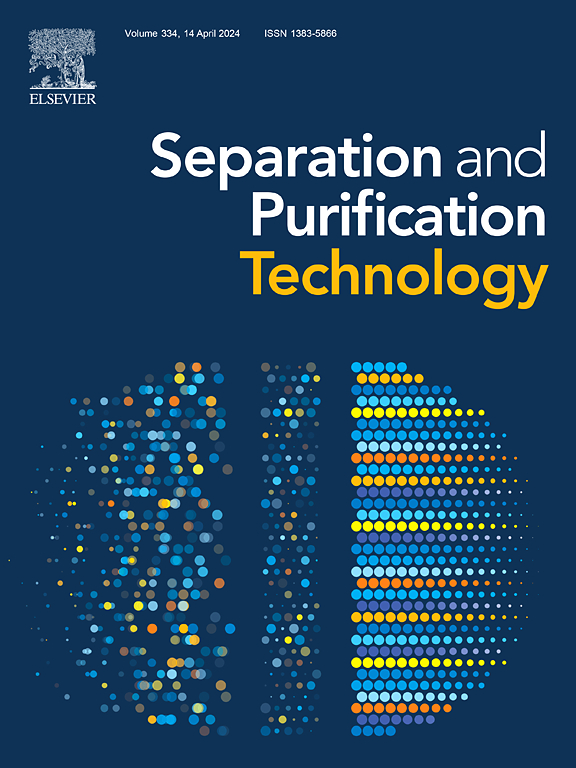氨基修饰双金属ZIF (Zn/Co-NH2)/聚酰亚胺基混合基质膜增强氢分离
IF 8.1
1区 工程技术
Q1 ENGINEERING, CHEMICAL
引用次数: 0
摘要
混合基质膜(MMMs)是一种很有前途的氢分离材料,它将聚合物的可加工性与无机填料的渗透性和选择性相结合。然而,填料聚集和聚合物-填料界面相容性差等问题限制了它们的性能。本研究合成了氨基修饰的双金属ZIF (Zn/Co-ZIF-NH2),并将其作为新型纳米填料用于制备6fda - dam基聚酰亚胺mm,旨在提高填料与聚合物基体的界面相容性。在ZIF-8-NH2中加入Co2+离子引入了协同效应,优化了金属-配体键连接的刚性和柔韧性之间的平衡,而氨基促进了与聚合物基体的强大界面相互作用。与纯聚合物膜相比,含有40 wt% MOF的MMM具有显著的气体渗透性,H2渗透率从750 Barrer增加到3273 Barrer, CO2渗透率从840 Barrer增加到2733 Barrer,分别提高了336.4 %和225 %。同时,H2/CH4和CO2/CH4的选择性分别提高到33.7和28.1,分别比原始聚合物提高了88.3% %和41. %。这些性能指标超过了2008年的Robeson上限,证明了Zn/Co-ZIF-NH2纳米填料在克服渗透选择性权衡方面的有效性。该研究强调了氨基改性双金属mof作为高性能MMMs的先进填料的有效性,尤其适用于氢气净化和二氧化碳分离应用。本文章由计算机程序翻译,如有差异,请以英文原文为准。

Amino-modified bimetallic ZIF (Zn/Co-NH2)/Polyimides-based mixed matrix membranes for enhanced hydrogen separation
Mixed matrix membranes (MMMs) have emerged as promising materials for hydrogen separation, combining the processability of polymers with enhanced permeability and selectivity offered by inorganic fillers. However, challenges such as filler aggregation and poor polymer-filler interfacial compatibility limit their performance. In this study, amino-modified bimetallic ZIF (Zn/Co-ZIF-NH2) was synthesized and employed as a novel nanofiller to fabricate 6FDA-DAM-based polyimide MMMs, aiming to improve interfacial compatibility between the filler and the polymer matrix. The incorporation of Co2+ ions into ZIF-8-NH2 introduced a synergistic effect, optimizing the balance between the rigidity and flexibility of metal-to-ligand bond linkage, while amino groups promoted robust interfacial interactions with the polymer matrix. Compared to the pure polymeric membrane, the MMM incorporating 40 wt% MOF exhibited a significant enhancement in gas permeability, with H2 permeability rising from 750 to 3273 Barrer and CO2 permeability increasing from 840 to 2733 Barrer, corresponding to improvements of 336.4 % and 225 %, respectively. Simultaneously, H2/CH4 and CO2/CH4 selectivities increased to 33.7 and 28.1, representing improvements of 88.3 % and 41 % over the pristine polymer. These performance metrics exceed the 2008 Robeson upper bounds, demonstrating the effectiveness of Zn/Co-ZIF-NH2 nanofillers in overcoming the permeability–selectivity trade-off. This study underscores the effectiveness of amino-modified bimetallic MOFs as advanced fillers for high-performance MMMs, particularly suited for hydrogen purification and CO2 separation applications.
求助全文
通过发布文献求助,成功后即可免费获取论文全文。
去求助
来源期刊

Separation and Purification Technology
工程技术-工程:化工
CiteScore
14.00
自引率
12.80%
发文量
2347
审稿时长
43 days
期刊介绍:
Separation and Purification Technology is a premier journal committed to sharing innovative methods for separation and purification in chemical and environmental engineering, encompassing both homogeneous solutions and heterogeneous mixtures. Our scope includes the separation and/or purification of liquids, vapors, and gases, as well as carbon capture and separation techniques. However, it's important to note that methods solely intended for analytical purposes are not within the scope of the journal. Additionally, disciplines such as soil science, polymer science, and metallurgy fall outside the purview of Separation and Purification Technology. Join us in advancing the field of separation and purification methods for sustainable solutions in chemical and environmental engineering.
 求助内容:
求助内容: 应助结果提醒方式:
应助结果提醒方式:


